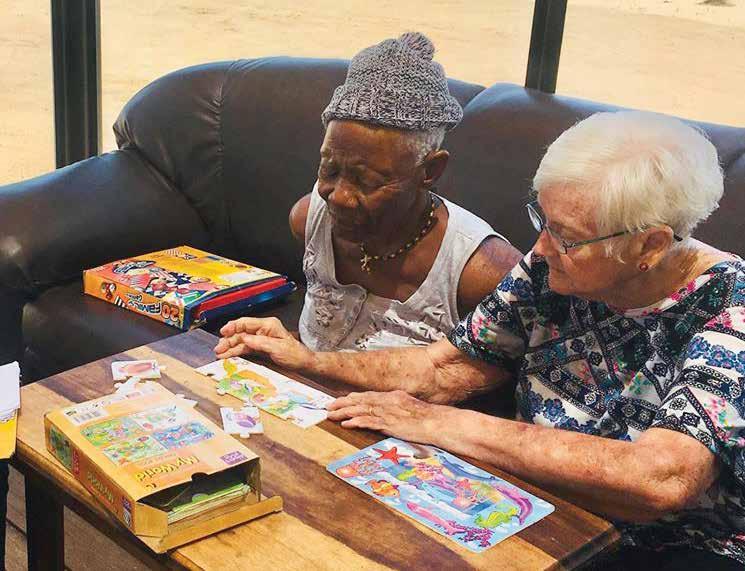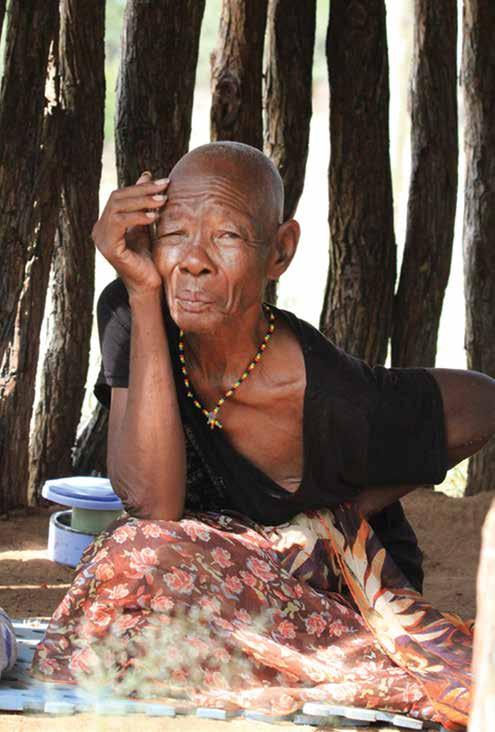
8 minute read
SEPARATING THE DEMONS FROM DEMENTIA with Berrie Holtzhausen
SEPARATING THE DEMONS FROM DEMENTIA
Berrie Holtzhausen started an old-age home for thirteen people in Swakopmund in 2009. Moved especially by the plight of dementia sufferers, Berrie started to learn about the disease and subsequently started Alzheimer’s Dementia Namibia.
Little did he know then that his compassion would open a Pandora’s box of ancient customs, fear, superstition, and lack of education regarding mental illness in traditional rural Africa, where dementia can result in sufferers being ostracized, imprisoned, neglected and even abused by their own families and communities.
While visiting a bush community in a remote Himba village in 2012, he came across a woman chained to a post in a mud hut. Accused of being a witch, she had been there for over twenty years. He immediately diagnosed her with dementia. Berrie proceeded to negotiate her release and began his mission to prevent the mentally ill from being drugged, chained or murdered.
Compelled by this experience, Berrie started a relentless and challenging journey to find and help more sufferers, to create awareness, to campaign against the witchcraft culture that drives inhumane and unconstitutional practices, and to fight for change.
WITH BERRIE HOLTZHAUSEN
Over the years, Berrie has faced many obstacles and put his own life in danger for this cause. In 2018, a documentary of his story was produced by Cloud Break Pictures, a division of Edinburgh-based video production company Heehaw, directed by Mally Graveson and Toby Trueman. The film screened at film festivals in the US and Europe, picking up four awards.
It is the love he has for people that pushes him to continue saving lives.
“On a visit to the village, I heard a woman screaming and shouting. They told me not to pay attention – she was a dangerous witch. I asked if I could see her.
“One of the signs of dementia is that the part of your brain that manages language disintegrates, so you’ll look for words. You’ll want to say you’re thirsty, but you can’t find the word for ‘water’ or ‘thirsty’. I took a translator along but the only words the woman could say properly in her language was, ‘I need tobacco from Sesfontein.’ More than that the translator couldn’t identify, because the woman was speaking incoherently, unable to put sentences together, which is a symptom of dementia. They can’t find the words in their brain, and they can’t put words together properly.
“But I could see that she was so hungry and so thirsty. She was only given one cup of water to drink a day and whatever food was left over was shoved to her with a stick.
She was chained to a pole and a fire burned in the opening of the hut. For twenty years . . .”
Disturbed by the incident, Berrie wanted to speak to the chief to explain what he believed the problem was – but he would have to wait two weeks for the chief to return to the village.
“I said to my friend, ‘We need to negotiate it, we need to unchain her, we need to start caring for her, because
I know this disease. I’m sure this is dementia.’ I’m not a doctor but the signs were very common for me. So, two weeks later, my friend phoned me and said, ‘Okay, Kapika is back.’ I went back 900 kilometres and we met Kapika under a tree and explained who I was and what I do. I said to him that I wanted to help – I don’t think one can keep someone like this chained for so many years.
“He said, ‘Ndjinna, she’s dangerous,’ and he showed me a mark on his forehead. He said that one night very late there was a commotion in the village, fireworks and shouting, and goats and the cattle very restless, and when he got out of his hut, Ndjinna was standing there. She had managed to unchain herself from the pole of the hut. Inside the hut was nothing, not the skin of cattle to sleep on, not a blanket, and it was a toilet inside there. He said to me she had managed to unchain herself from the pole of the hut, got out of the hut and she’d strangled six goats with her bare hands.
“I think she was driven by hunger and thirst. And when she was caught, she grabbed a piece of wood and she nearly killed him. She hit him over the head because she was frantic. I understood what had happened. I said, ‘Don’t worry. I’m not afraid.’”
Berrie took two young women from the community to his farm to show them where and how he cared for people with dementia, to show them that it’s not witchcraft, but an illness that many people have. He trained them in identifying the different symptoms and how to care for someone who can’t eat anymore, who can’t use language to say when they are in pain, or hungry, or thirsty. After two months of training, he took them back and set up a village with five huts where Ndjinna could live and be taken care of.
“So we unchained her and everyone from the villages came to see this unchaining of a witch who can fly at night, according to their belief, and to see what was going to happen to this white man.
“We put up some plastic sheets to make a bathroom and I brought a lot of water with me. So they bathed her in twenty litres of water – cleaned her, after twenty years of having no water over her body. We dressed her nicely. Up until then, she couldn’t walk up straight after being hunched in the hut for so long, but after we had bathed her and dressed her, she came out from behind that plastic sheet walking up straight.
“It took us sixteen months to organise her a piece of ground where we could build her a village for herself. We built a Himba village of five huts. She was then the chief in command of the village, and these ladies cared for her. She could collect wood but she couldn’t make the fire, for instance. And she was never aggressive again.
“The only way to treat people with dementia is with dignity, with love. Chief Kapika asked me that day, ‘How are you going to treat her? Are you a doctor’? I said no. ‘Are you a witch doctor?’ I said no. ‘Now how are you going to treat her?’ he asked me.
I said, ‘With love.’
“I trained them to understand the broader picture, to make sure that she had enough to drink, enough to eat, to sleep well. They should walk with her in the veld, see the goats, listen to the goats, touch the donkeys and the cattle – you know, things she was used to but hadn’t done in twenty years. Listen to her songs that she was singing and sing with her. The songs about the colour of the cattle and so on.”
Berrie cared for her there for five and a half years. They drilled a borehole and put up a 10 000-litre tank for her. She provided drinking water to Chief Kapika’s very own cattle and his goats.
“But after five and a half years, I noticed that they were not good for her any more. They started stealing her clothes, her food. I went to visit to see that she was alright, and I could see that she was afraid – she was hiding behind the hut like a scared little child. I said to my friend, ‘No. No, now I’m going to take her out of her culture.’ I don’t believe in this – I believe
that everyone needs to be cared for by their own family groups and their own culture, but I said, ‘No, I’m taking her down to Swakopmund, to our place,’ and I did just that.”
Realising that there must be many cases of so-called ‘bewitched’ people in the rural areas of Namibia, Berrie started travelling to the Okavango, Zambezi and Ovamboland, where he found many people suffering from dementia, misunderstood and rejected by the community.
“There are all these behavioural symptoms that people don’t understand. Hallucinations – they get anxious and walk up and down, and can’t find their way back. They talk to people who are not there any more, who they knew long ago. That makes people very scared.
“When certain parts of the brain go, they need to wear diapers; they become incontinent. There’s no signal between the brain and muscles any more, so they can’t swallow their food, and then some of the food ends up in their lungs.
“Other symptoms are cognitive. They can’t plan, they don’t have insight into problems. They are like small children. These are BPSD – the behavioural and psychological symptoms of dementia.
“So you need to have compassion. You need to love them. You need to know their life history because they do time
travelling – they go back to realities far away. Their senses can trigger memories from different times. Smelling coffee, for instance, will trigger a time in their life when they often went to coffee shops with their loved one. For them it’s real – they are in that coffee shop, they can see that coffee shop, they can see the coffee. It’s amazing how the brain works.
“If you don’t know this, you can’t care for them. You think they’re just stupid, they’re mad, and there is all this stigma and discrimination.
Dementia, or Alzheimer’s, kills the part of the brain that affects recognition. It destroys it and then it’s gone forever – it will be as if they’ve never met you. You can imagine how scary and confusing life must be for these people. So let’s get rid of the stigma and the discrimination. Your brain is an organ, it’s not a place for demons and devils to live in.”
Ndjinna still lives in Berrie’s home for the elderly in Swakopmund, where she is happy.
YOU CAN WATCH AFRICAN WITCHFINDER ON WWW.CLOUDBREAKPICTURES.COM/ AFRICAN-WITCHFINDER AND WWW.BLOG.ALZ. CO.UK/2019/09/20/AFRICAN-WITCHFINDER-AFILM-ABOUT-DEMENTIA-STIGMA-IN-NAMIBIA-ANDSOUTH-AFRICA
ALZHEIMER’S DEMENTIA NAMIBIA CAN BE REACHED VIA THEIR WEBSITE, WWW.ALZHEIMERSDEMENTIANAMIBIA. WORDPRESS.COM, OR ON THEIR FACEBOOK PAGE












